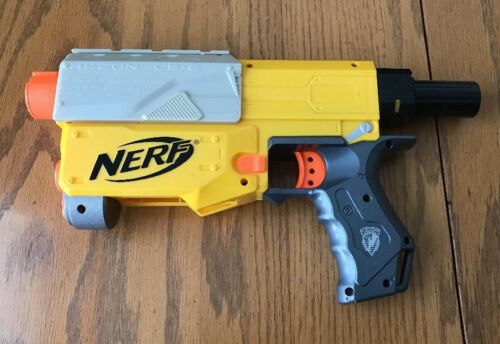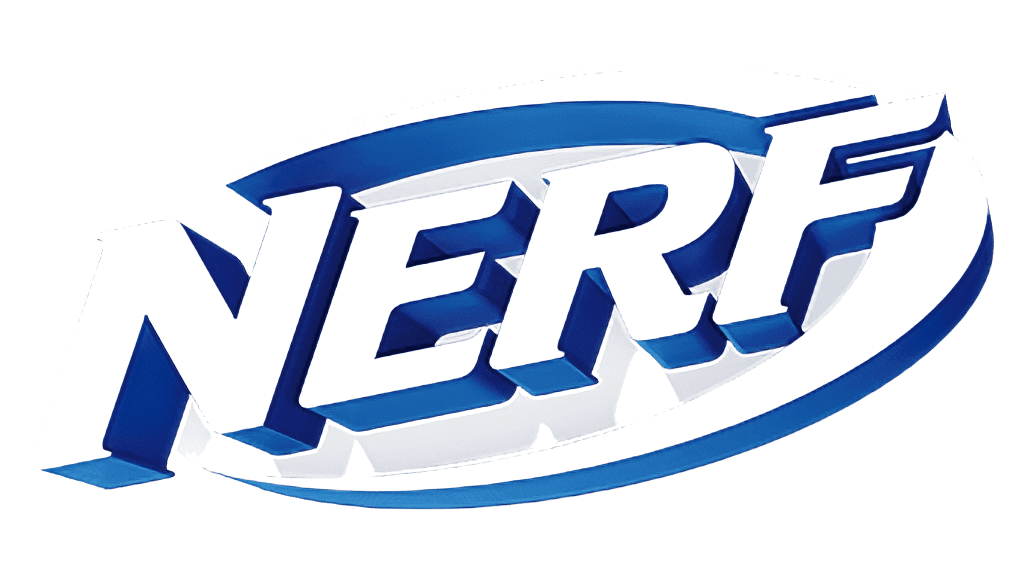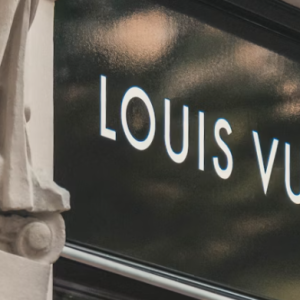The Nerf brand needs little to no introduction. As a child, you surely came across a Nerf blaster at some point in time. And when you picked up that blaster, no one could stand in your way – you were invincible.

For so many of us, Nerf is a nostalgic brand so whenever we see those toy Nerf products even today, we are immediately brought back to our childhood. Nerf’s business model works because the brand still gives children today the same feeling we once got when we grabbed our toy blaster full of foam ammunition.
If a company gives us nostalgia, that means the company has been around for a while and has done something right. Nerf is one of those brands, but we would guess that you likely don’t know the ins and outs about them even though you love the brand. To learn more about this iconic childhood staple and Nerf’s path to success, keep reading below where we take a deeper dive into all things Nerf.
Meet Nerf

Nerf, which stands for Non-Expanding Recreational Foam, was founded back in 1969 by Parker Brothers after Reyn Guyer, a Minnesota-based inventor approached the company. Reyn proposed to Nerf a safe indoor football game. Parker Brothers decided to get rid of the game component and simply just launch the Nerf ball on its own.
When Nerf was launched it was launched with two marketing slogans, “Throw it indoors without breaking windows or damaging lamps” and “You can’t hurt old people or babies.” Their marketing campaign flourished, and Nerf began to explore partnerships with Kool-Aid and Davy Jones, Micky Dolenz, and Michael Nesmith. The Nerf ball exceeded everyone’s wildest expectations and by 1970, over 4 million Nerf balls were sold.

This small Nerf ball helped Nerf discover what their customers wanted and after this first release, Nerf released a series of other products. While the brand was expanding, Hasbro bought The Tonka Corporation, which owned Parker Brothers, in 1991. Before Hasbro acquired Tonka, Nerf fell under Larami and OddzOn’s subsidiaries.
As the years went on, Nerf continued to release new products and in 2013, Nerf even released a girls-only line and “The Ultimate Nerf Blaster Book,” which was the first time Nerf entered the book market.
The same logo we all grew up to know and love is the same logo you’ll see on Nerf’s products today (with some slight variation). Nerf is a globally recognized brand and for a company that has been around for over 50 years, we can all learn something from this iconic brand.
Nerf’s Evolution
If you go back about 50 years, you’ll find the first Nerf product which helped get the Nerf brand to where it is today. Let’s look closely at Nerf’s evolution over the last 50+ years.

1969: Nerf is founded
Founded under Parker Brothers, the Nerf ball, Nerf’s first product, was released in 1969. In just over one year, over four million of these Nerf balls were sold.
1972-1989: Nerf expands their offerings
After the Nerf ball was an instant success, Nerf introduced the Nerfoop, a basketball game, and the Nerf football in 1972. These products together are responsible for the Nerf Sports division of the brand.
The next addition to the line was the Nerf Baseball in 1983. What drew consumers to this product was that, unlike actual baseball, Nerf Baseball could be played inside your home.

In 1989, a different type of product was released – the Power Drencher, also known as the Super Soaker. This was invented by Lonnie Johnson, an Atlanta aerospace engineer. This product changed the water blaster industry. Nerf updated this blaster’s name to the Super Soaker 50. What was so unique about Nerf’s water blasters was that they used a trademarked air pressure technology which allowed for water to be fired much faster and further than any of their competitor’s products.

1991: Parker Brothers is bought out
Parker Brothers belonged to The Tonka Corporation, which was purchased by Hasbro, Inc. in 1991. With this purchase, Nerf now fell under Hasbro’s umbrella. After this acquisition, Nerf released yet another product, this time their first bow and arrow creation. The following year, Nerf released yet another product, their first Nerf dart blaster called the Nerf Sharpshooter.

2004-2008: The N-Strike is introduced
In 2004, the N-Strike was introduced. This product took the past Nerf blasters to a whole new level. With the N-Strike, you also got the Unity Power System that included three blasters that you can fire either simultaneously, or individually. This helped drive the continuous innovation of the Nerf brand. After N-Strike was released, Nerf began to experiment more with different layouts and universal parts.

If you fast forward a few years to 2008, a new addition to the N-Strike line was released, called the Nerf Vulcan blaster. Even today, you’ll have trouble finding any blaster that is larger or better than the Vulcan.
2011-2013: Nerf continues to expand their product line

Their next product was the Nerf Vortex range of disc throwing blasters which was released in September 2011. The following year, a new Firevision range let users play with their Nerf blasters at nighttime. All the players had to do was wear the Fire Frames eyewear and the reflective Firevision technology. When players did this, they didn’t need to worry about losing sit of the Nerf ball, even in the dark.
Another product that was released was the Centurion blaster. This blaster used mega whistler darts, which Nerf had never done previously.
2014: Nerf turns 45

2015-2019: Nerf continues to release new products
To celebrate Nerf’s 45th birthday, the brand extended several of its product lines and released new blasters that outperformed previous ones. Some of these products included free-play and a built-in camera.
Nerf continued to pay attention to what their customers wanted and released the Nerf Rival range in 2015. This was created for users over the age of 14 and allowed users to customize their blasters. The next year, in 2016, Nerf introduced a remote-controlled blaster drone named the N-Strike Elite Terrascout RC. This blaster was equipped with a camera and live video, an 18-dart pin, and could be used both indoors and outdoors.
In 2017, Nerf updated its N-Strike range with the Accustrike range. Two years later, in 2019, Nerf released a line of Fortnite blasters to maximize the Fortnight hype. This allowed for players to have a “Battle Royale” type of experience with their Nerf blasters.

2021: Nerf shows no signs of slowing down
For a brand that has been around for so long, Nerf continues to create new innovative products to release. In 2021, Nerf created the Nerf Hyper system which includes rounds that are made from an innovative, new material. These rounds are the best ones created yet when it comes to performance and speed.
Roadblocks Along the Way
When it comes to Nerf, the biggest roadblock the brand has encountered has been related to keeping its products new and exciting. How they have been able to navigate this roadblock is by listening to their customers and responding to the changing needs and wants of their consumers.
Another roadblock they encountered was in 1991 when their parent company was bought out. Some companies would have needed to conform to their new parent company’s style, but Nerf was able to keep doing what they were doing.
The Meaning of Nerf’s Logo and Nerf’s Logo History
Nerf’s logo has always been simplistic. Featuring solely text, the company’s logo is straightforward which certainly has helped them generate brand awareness. Despite it being a simple logo, the logo has been updated over the years. Below we take a deeper dive into this logo’s evolution.

1969-1990: The first version of the Nerf logo
With Nerf’s initial launch, Nerf’s initial logo was released. This first version lasted for about twenty years and the design elements were minimal. When Nerf released its first product, a ball, the brand needed a logo to identify the brand – and that is when this logo was born.
This logo was predominantly yellow, and the letters were written in a fantasy style. This logo conveyed an informal tone with the “N,” “R,” and “F” all capitalized, while the “E” remained lowercase.

1990-1992: The second version of the Nerf logo
After 20 years, Nerf felt it was time to update its logo. This updated version lost some of the playful components though.
The letters were still written informally and the yellow color was still present, however, this logo also featured darker shades and incorporated red and green coloring, with rectangles behind the Nerf wordmark.

1992-1998: The third version of the Nerf logo
The second logo only lasted for two years and in 1992, the third version was created. This version ditched some of the playful features of the past logos and instead opted for more mature touches. The font looked more professional, yet still utilized a creative “serif” font for the letters.
Another new feature of this logo was the addition of a blue circle in the background, which portrayed the first Nerf foam ball that was released. The only features that were still able to accurately convey the playfulness of the brand were the bright colors that were chosen.

1998-2003: The fourth version of the Nerf logo
Following in the footsteps of the third version, this fourth iteration also felt professional and resembled a professional sports logo. Nerf ditched the serif font and instead opted for a standard italicized typography.

2003 – 2004: The fifth version of the Nerf logo
After releasing two logos that had a more mature look, Nerf released a logo that went back to its childlike features. This logo resembled what a child would create when asked to write “Nerf.” The lines of the letters also felt like a child’s finger painting, rather than writing with a pen or marker.

2004 – 2020: The sixth version of the Nerf logo
After the brief childlike logo, Nerf returned to its sporty roots with this iteration. This coloring was also different with the yellow having a browner tint against the blue background. A new component that was added was a red swoosh, which made it feel sportier than the previous logo.

2020 – Present: The seventh version of the Nerf logo
The logo you’ll find today is this seventh version. This iteration has a 3D feel due to the arc and “Nerf” being written in silver. This silver has a variety of shades, and a blue gradient is also highlighted in the logo. These color choices portray a see-through effect which gives this logo a 3D feel.
Nerf’s logo font:

While the fonts have varied over the years, the most iconic font Nerf has used is Letraset Crillee. This font was designed specifically for Nerf by Dick Jones, Vince Whitlock, and Peter O’Donnell. This font was designed between 1987 and 1990 and you’ll notice that this custom font is bold with short triangle-shaped serifs. Even when the font shifted through the years on the logo, elements of this font were always incorporated.
Nerf’s logo color:
The designers played around with different colors throughout the years but overall, the color palette has been consistent. Yellow has been a primary recurring color; you’ll always find some version of this in the logos. Other colors were added throughout the years like red, blue, and silver, but some hint of yellow was always there as well.
Nerf’s logo symbols:
The main feature of Nerf’s logo is the wordmark which clearly states the brand’s name. However, on some versions, you’ll see a circle or round ball. This symbol represents the first Nerf product that was released, the Nerf Ball.
Nerf Today

Since being purchased by Hasbro, Inc. in 1991, Nerf has remained part of Hasbro’s brand. Originally founded under Parker Brothers, Nerf’s product offerings span from foam-based blasters, water blasters, balls, games, and more. Nerf’s most popular product is its dart blasters which can rapidly fire “Nerf foam” ammunition.
It’s been over 50 years since the first Nerf product was released and 50 years later, Nerf is showing no signs of slowing down.
Lessons Learned from Nerf
The biggest takeaway from Nerf’s logo is that your logo can simply be your brand’s name. Nerf’s logo has always been about the “Nerf” name and no matter how many updates were made to the logo; this always was the case. Even when the logo went back and forth between childish, sporty, and professional elements, the name “Nerf” was always the focal point.








